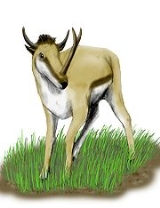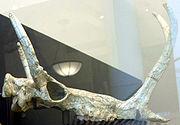
Synthetoceras
Encyclopedia
Synthetoceras is a large extinct genus
of Artiodactyla, of the family Protoceratidae
, endemic to North America
from the Miocene
epoch, 13.6—5.33 Ma, existing for approximately .
, Synthetoceratini
. It was assigned to Protoceratidae
by Stirton (1932), Thurmond and Jones (1981) and Carroll (1988); to Synthetoceratinae by Hulbert and Whitmore (2006); and to Synthetoceratini by Webb (1981), Prothero (1998), Webb et al. (2003) and Prothero and Ludtke (2007).

s. The two horns above its eye
s looked fairly normal and similar to those of many modern horned mammals, but on its snout it had a bizarre, long horn with a fork
ed tip that gave it a Y shape. Only males had this strange horn, and they probably used it in territorial fights.
Genus
In biology, a genus is a low-level taxonomic rank used in the biological classification of living and fossil organisms, which is an example of definition by genus and differentia...
of Artiodactyla, of the family Protoceratidae
Protoceratidae
Protoceratidae is an extinct family of herbivorous North American artiodactyls that lived during the Eocene through Pliocene at around 46.2—4.9 Ma., existing for approximately .-Taxonomy:...
, endemic to North America
North America
North America is a continent wholly within the Northern Hemisphere and almost wholly within the Western Hemisphere. It is also considered a northern subcontinent of the Americas...
from the Miocene
Miocene
The Miocene is a geological epoch of the Neogene Period and extends from about . The Miocene was named by Sir Charles Lyell. Its name comes from the Greek words and and means "less recent" because it has 18% fewer modern sea invertebrates than the Pliocene. The Miocene follows the Oligocene...
epoch, 13.6—5.33 Ma, existing for approximately .
Taxonomy
Synthetoceras was named by Stirton (1932). It is the type genus of SynthetoceratinaeSynthetoceratinae
Synthetoceratinae is a subfamily of Protoceratidae herbivorous mammals belonging to the order Artiodactyla endemic to North America during the Miocene epoch, living 23.03—3.9 Ma, existing for approximately .-Taxonomy:...
, Synthetoceratini
Synthetoceratini
Synthetoceratini is an extinct tribe of the subfamily Synthetoceratinae within the family Protoceratidae belonging to the order Artiodactyla endemic to North America during the Miocene, living epoch 20.6—4.9 Ma, existing for approximately .-Taxonomy:...
. It was assigned to Protoceratidae
Protoceratidae
Protoceratidae is an extinct family of herbivorous North American artiodactyls that lived during the Eocene through Pliocene at around 46.2—4.9 Ma., existing for approximately .-Taxonomy:...
by Stirton (1932), Thurmond and Jones (1981) and Carroll (1988); to Synthetoceratinae by Hulbert and Whitmore (2006); and to Synthetoceratini by Webb (1981), Prothero (1998), Webb et al. (2003) and Prothero and Ludtke (2007).

Morphology
With a length of 2 m (6 ft 8 in), Synthetoceras was the largest member of its family. It was also the last, and had what is considered to be the protoceratids' strangest set of hornHorn (anatomy)
A horn is a pointed projection of the skin on the head of various animals, consisting of a covering of horn surrounding a core of living bone. True horns are found mainly among the ruminant artiodactyls, in the families Antilocapridae and Bovidae...
s. The two horns above its eye
Eye
Eyes are organs that detect light and convert it into electro-chemical impulses in neurons. The simplest photoreceptors in conscious vision connect light to movement...
s looked fairly normal and similar to those of many modern horned mammals, but on its snout it had a bizarre, long horn with a fork
Fork
As a piece of cutlery or kitchenware, a fork is a tool consisting of a handle with several narrow tines on one end. The fork, as an eating utensil, has been a feature primarily of the West, whereas in East Asia chopsticks have been more prevalent...
ed tip that gave it a Y shape. Only males had this strange horn, and they probably used it in territorial fights.
Body mass
Three fossil specimens of Poabromylus were measured by M. Mendoza, C. M. Janis, and P. Palmqvist for body mass. The specimens were determined to weigh:- Specimen 1: 332.4 kg (732.8 lb)
- Specimen 2: 228.3 kg (503.3 lb)
Fossil distribution
Fossils have been recovered from:- Stage Hill II, Arikaree Group, Wildcat Hills Beds Formation, Scotts Bluff County, NebraskaScotts Bluff County, Nebraska-National protected area:* North Platte National Wildlife Refuge* Scotts Bluff National Monument-Demographics:As of the census of 2000, there were 36,951 people, 14,887 households, and 10,167 families residing in the county. The population density was 50 people per square mile . There were 16,119...
- Guernsey Site, Upper Harrison Beds Formation, Platte County, Wyoming

